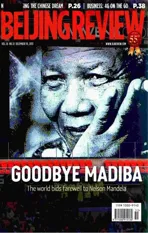Welcome to 4G Era
2013-04-29
Life Weekly December 2
Chinas Ministry of Industry and Information Technology is about to officially issue fourth-generation (4G) mobile network licenses, ushering the whole country into the 4G era.
“Fast” is the most outstanding feature of 4G. With a download speed of 100mb/s, 4Gs transmission speed is about 10 times faster than 3G. It only takes about two minutes to download a 1G video.
In Hangzhou, an experimental city for 4G in east Chinas Zhejiang Province, 4G network service is free on one of its bus lines. More than 10,000 passengers surf the Internet on the bus every day.
The 4G network will greatly promote the mobilization of information, enable users to get online anytime and anywhere, and realize a seamless virtual work and life. To embrace the 4G network, cellphone producers have accelerated the release of new cellphones. By the end of 2013, there will be about 22 new designs of cellphones on the market in China. At the beginning of 2014, there will also be cheap 4G cellphones.
In 2014, China mobiles 4G network will cover 326 cities across the country, which translates to a huge amount of infrastructure construction and big orders of communication devices. Whats more, with the rapid popularization of 4G, relevant service products and application products will also undergo a golden time.
Protecting Measures Beijing Morning Post December 9
The ancient tombs of northwest Chinas Qinghai Province are the biggest group of Tubo tombs on Chinese territory. Chinas State Administration of Cultural Heritage has listed the site as a major archeological discovery and named it “the oriental pyramid”on the south Silk Road of the Qinghai-Tibet Plateau.
In the 1980s, in search of a big payday, grave robbers began non-stop rampant digging and robbing in this area, causing immeasurable loss to the country. The question is, since the tombs are such significant historic relics, why is grave robbing still so widespread? Are there any protection measures in place?
This “oriental pyramid” covers an area of 21,000 square kms, with only two groundkeepers. Obviously, the efforts to safeguard these precious relics are far from adequate. The 200 tombs in Reshui Township were all damaged with no exception.
One cant help but ask whether relevant departments, before announcing a certain site as a key protection unit, have finished support work such as protection, daily management and overall planning? If not, the revelation of “major historic relics” is an invitation to grave robbers.
Calling for a Safety Net
Yangcheng Evening News December 9
After his story came to light, a man surnamed Wang who had lived in a well in Beijing for two decades due to poverty, has attracted a lot of attention. Many organizations have offered jobs to him. His three children will also be supported by some generous people until they finish getting a college education.
Wang is lucky. Thanks to news reports, his difficulties were solved within days, and the well he used to live in has been covered over by cement for the sake of public safety.
According to statistics from the National Health and Family Planning Commission, Chinas migrant population is estimated to be around 236 million. Following the “well man” event, a new round of social assistance may help some people, but for the masses of migrant population, particularly the elderly, life underground in wells or in other corners of cities will continue.
However, social assistance is not the fundamental solution to this issue. What the current Chinese society needs is assistance to the disadvantageous group at a legal and systemic level.
Chinas Ministry of Civil Affairs has announced plans to establish a full social security system covering people living in poverty and facing difficulties, including people like Wang. Its hoped that this blueprint will become reality as soon as possible.
Jogging Fashion
China Newsweek December 2 It seems that jogging has become an overnight fashion in China. In cities, people are sharing their running routes, equipment and results on various online platforms such as social networks. And marathon races, which used to be regarded as dull and boring, is now a more popular activity for urban residents.
Behind the transformation of jogging from a dull sport into a fashion icon are profound social and cultural reasons. Today, people live in an environment with poor air quality, harsh career competition, a fast pace and increasingly distant inter- personal relations. They are wrapped up in anxiety, restlessness and confusion. Running serves as an excellent way out of all these.
Many people choose to jog initially for the sake of physical health. With time, jogging becomes a mental need for them. It creates precious moments when people can talk to themselves in peace amid this noisy world. While jogging, people can either sort out the thoughts in their mind or empty the mind by thinking about nothing and simply enjoy the quietness.
